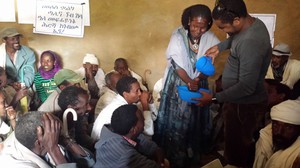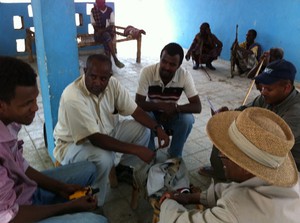Much research has been done on good practice in community mobilisation and the evidence for effective strategies tends to come from these studies and experiences. They show that community mobilisation can change attitudes, norms, practices and individual behaviours (Pact Tanzania, 2006). Figure 11.2 shows a community mobilisation process in which a demonstration of effective handwashing practice is taking place.

Figure 11.2 Community demonstration of critical moments of handwashing.
Community mobilisation is not a task for one person working on their own. It needs a team of people each with different roles who work collaboratively with the community. The team needs to include technical support staff and people with skills in project management as well as the key facilitators who have the main role of liaising with the community.
Developing a strategy for community mobilisation to address a particular problem requires:
The key steps of knowing your community and prioritising projects are described in more detail in the following sections.
To mobilise your local community effectively, you need know about its social organisation, economy, problems and politics. This information can be obtained from many sources, both formal and informal, and might include (Pact Tanzania, 2006):
Through stakeholder mapping (as described Study Session 4) you will begin to understand the nature of your community as a social system. Think about how the different elements of the community such as the children, women, youth and local organisations are connected to each other. You will soon realise that a community is not merely a collection of individuals but a system that involves a lot of intricate links and relationships between those individuals. People enter and leave the community, by birth, death and migration, so it is constantly changing and yet it continues to exist.
Getting to know your community is not something that can be achieved quickly. You will need time to develop relationships with the community members. For successful community mobilisation you need to know what will motivate people to become involved and this requires understanding of their interests and concerns.
Stakeholder mapping will also help to identify the key stakeholders in WASH and especially those who are the existing leaders within the community. Working with existing leaders is much more likely to be successful because other community members will be influenced by them and follow their lead (Mercy Corps, 2013).
Part of the process when trying to mobilise a community is to work with them to identify and prioritise possible projects, as shown in Figure 11.3. There are several approaches for project prioritisation.

Figure 11.3 Prioritisation meeting at Kori, Afar.
Some Ethiopian towns already have Water and Sanitation Master Plans that have been prepared through a consultative process with the local population. If such a plan exists, this is a good place to start because this will have identified the most important water and sanitation problems for the town. If not, your WASH project prioritisation procedure might follow these steps: